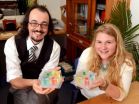(Press-News.org) EAST LANSING, Mich. --- Mom or dad may have driven you to cello rehearsal all those years, but you can also thank your genes for pushing you to practice, according to new research led by a Michigan State University professor.
Genetics and environment work together to help people become accomplished musicians, finds the study of 850 sets of twins. It's another arrow in the quiver of the argument that both nature and nurture play a role in developing expertise.
"The nature vs. nurture debate has raged since the beginning of psychology," said Zach Hambrick, MSU professor of psychology. "This makes it very clear that it's both. Not only in the sense that both nature and nurture contribute, but that they interact with each other."
The study breaks new ground in ascertaining the specific roles of genes. Essentially, it found:
Accomplished musicians practiced much more than those who weren't accomplished.
That propensity to practice was fueled partly by genetics, which the researchers were able to establish by comparing identical twins, who share 100 percent of their genes, with fraternal twins, who share 50 percent of their genes. The finding suggests genetics influence the sorts of activities we pursue.
When it came to music accomplishment, genes had a bigger influence on those who practiced than those who didn't.
Writers such as Malcolm Gladwell argue that experts are almost entirely "made" and that a lack of innate ability can be overcome with enough training. The way to master that cello, in other words, is to practice for at least 10,000 hours, as past research has suggested.
But the new study challenges that theory by showing genes had a major contribution on the musicians who practiced and became successful. For those who didn't practice, there was essentially no genetic contribution.
"Contrary to the view that genetic effects go away as you practice more and more," Hambrick said, "we found that genes become more important in accounting for differences across people in music performance as they practice."
INFORMATION:
The study appears online in the journal Psychonomic Bulletin & Review. Hambrick's co-author is Elliot Tucker-Drob from the University of Texas.
Rosin up that bow, maestro. And thank your genes
2014-06-26
ELSE PRESS RELEASES FROM THIS DATE:
Packing hundreds of sensors into a single optical fiber for use in harsh environments
2014-06-26
WASHINGTON, June 26, 2014—By fusing together the concepts of active fiber sensors and high-temperature fiber sensors, a team of researchers at the University of Pittsburgh has created an all-optical high-temperature sensor for gas flow measurements that operates at record-setting temperatures above 800 degrees Celsius.
This technology is expected to find industrial sensing applications in harsh environments ranging from deep geothermal drill cores to the interiors of nuclear reactors to the cold vacuum of space missions, and it may eventually be extended to many others.
The ...
NNI releases progress review on environmental, health, & safety research
2014-06-26
The National Nanotechnology Initiative (NNI) released today a Progress Review on the Coordinated Implementation of the National Nanotechnology Initiative 2011 Environmental, Health, and Safety Research Strategy, a document that demonstrates the wide range of research activities, accomplishments, and collaborations of Federal agencies working toward the responsible development of nanotechnology.
This document is a result of efforts by the Federal agencies participating in the Nanotechnology Environmental and Health Implications (NEHI) Working Group. NEHI is a Working Group ...
Capturing CO2 emissions needed to meet climate targets
2014-06-26
This is shown by the most comprehensive study to date on technology strategies to combat climate change, published in a special issue of the journal Climatic Change. It is based on the analysis of 18 computer models by an international team of scientists under the roof of the Stanford Energy Modelling Forum (EMF 27).
"Versatile technologies seem to be most important to keep costs in check," says lead author Elmar Kriegler from the Potsdam Institute for Climate Impact Research. Both bioenergy and CCS can help reduce emissions from non-electric energy use that would be ...
Does psychostimulant use increase cardiovascular risk in children with ADHD?
2014-06-26
New Rochelle, NY, June 26, 2014—Psychostimulant use to treat children and adolescents with attention-deficit/hyperactivity disorder (ADHD) is increasing worldwide, and the evaluation of the cardiovascular safety of stimulant medication used in treatment has been a recent topic of concern. The results of the first nationwide study of the cardiovascular safety of stimulants in children and adolescents are published in Journal of Child and Adolescent Psychopharmacology (JCAP), a peer-reviewed journal from Mary Ann Liebert, Inc., publishers. The article is available free on ...
Which interferons best control viral infections?
2014-06-26
New Rochelle, NY, June 26, 2014—Respiratory and intestinal infections caused by RNA viruses stimulate infected cells to produce interferons, which can act alone or in combination to block virus replication. Important differences between the presence of IFN receptors on cells and new evidence that specific types of IFNs can control RNA virus infection are explored in a Review article in Journal of Interferon & Cytokine Research (JICR), a peer-reviewed publication from Mary Ann Liebert, Inc., publishers. The article is available free on the JICR website.
In "Type-I and ...
Iowa State engineers turn LEGO bricks into a scientific tool to study plant growth
2014-06-26
AMES, Iowa – Ludovico Cademartiri had what seemed like an impossibly demanding list of requirements for his lab equipment.
The Iowa State University assistant professor of materials science and engineering wants to understand environmental effects on plant growth, specifically how variations in climate and soil characteristics affect root growth. That requires highly controlled environments that expose whole plants to environmental effects such as nutrients, water, oxygen gradients as well as physical obstacles for the roots.
Greenhouses can create fairly controlled ...
Veterans who identify as LGB could benefit from informed mental health services
2014-06-26
COLUMBIA, Mo. – In 2011, the United States Military repealed its "don't ask, don't tell" policy that prevented gay and lesbian service members from disclosing their sexual orientation. Current estimates indicate that more than 1 million veterans identify as lesbian, gay or bisexual (LGB). Now, a University of Missouri researcher says these service members and veterans often are marginalized and may benefit from mental health professionals, including social workers, who are informed about the needs of individuals who identify as LGB.
"Identifying as LGB and serving in ...
Penn study shows changing roles of physicians with MBAs
2014-06-26
Philadelphia - According to a new study from researchers at the Perelman School of Medicine and the Wharton School at the University of Pennsylvania, physician graduates from the MBA program in heath care management at Penn's Wharton School report that their dual training had a positive effect on their individual careers and professional lives. Study respondents reported such benefits as career acceleration, professional flexibility, and credibility in multidisciplinary domains. Aside from clinical practice, the MD was more often cited as providing professional credibility, ...
Controlling movement with light
2014-06-26
For the first time, MIT neuroscientists have shown they can control muscle movement by applying optogenetics — a technique that allows scientists to control neurons' electrical impulses with light — to the spinal cords of animals that are awake and alert.
Led by MIT Institute Professor Emilio Bizzi, the researchers studied mice in which a light-sensitive protein that promotes neural activity was inserted into a subset of spinal neurons. When the researchers shone blue light on the animals' spinal cords, their hind legs were completely but reversibly immobilized. The ...
Why tech transfer brings universities 'more than money'
2014-06-26
Tampa, Fla. (June 26, 2014) – Academic technology transfer – the process of moving research from the lab to the market – provides intrinsic benefits to universities that go far beyond any potential revenues from licenses and royalties.
So say the authors, from five universities across the country and the Association of University Technology Managers (AUTM), in a new article from the National Academy of Inventors (NAI) that appears in the current issue of Technology and Innovation and is available Open Access.
"More than Money: The Exponential Impact of Academic Technology ...



